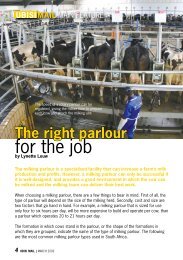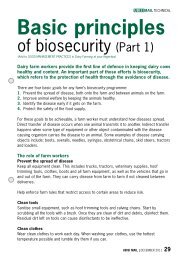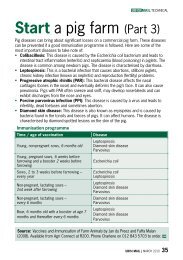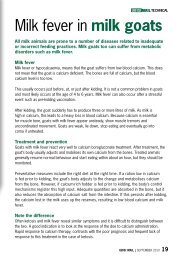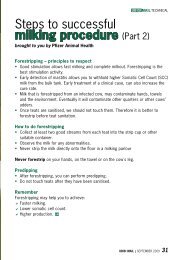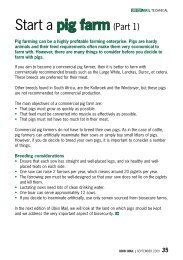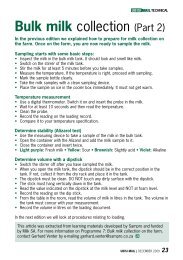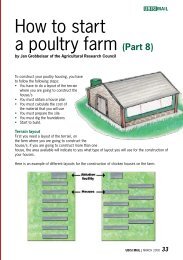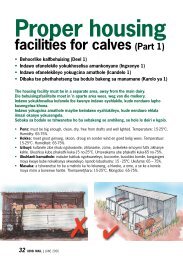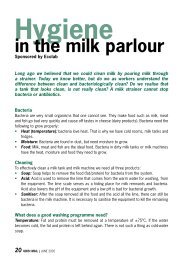Produce your own eggs (Part 2) - Ubisi Mail Magazine
Produce your own eggs (Part 2) - Ubisi Mail Magazine
Produce your own eggs (Part 2) - Ubisi Mail Magazine
Create successful ePaper yourself
Turn your PDF publications into a flip-book with our unique Google optimized e-Paper software.
<strong>Produce</strong> <strong>your</strong> <strong>own</strong> <strong>eggs</strong> (<strong>Part</strong> 2)<br />
Once you know which chickens you want to purchase, the first thing to do is to build<br />
a cage for <strong>your</strong> hens. There are many benefits to a chicken cage. A cage is easy to<br />
keep clean and <strong>your</strong> hens will remain together. It is also easier to collect <strong>eggs</strong>.<br />
Hens that are kept in a cage have less chance of contracting diseases from other chickens and<br />
there is less chance of them being stolen. With a cage, you can see when <strong>your</strong> hens’ drinking<br />
water is finished. Feed is not wasted as much as outside. You can also keep good record of <strong>your</strong><br />
hens’ egg production.<br />
Build <strong>your</strong> <strong>own</strong> hen cage<br />
To build <strong>your</strong> <strong>own</strong> cage you will need: A wire cutter, measuring tape, hammer, hacksaw, pliers,<br />
small spanner and marking pen. To house between nine and 12 hens, you will need to build a cage<br />
120 cm long, 70 cm wide and 45 cm high.<br />
The materials needed are galvanised welded mesh (the 25 x 50 mm type), a metal frame to keep<br />
the mesh in place, a 140 cm long gutter that you can buy from the cooperative or make <strong>your</strong>self.<br />
You will also need some plastic 2-litre cold drink bottels, an old hosepipe and some old feed bags.<br />
Also buy three drinking nipples from the cooperative.<br />
Start making the cage<br />
• Cut the mesh to the right length of 180 x 120 cm. Bend it until it is flat<br />
• Attach the mesh to the frame with pieces of wire<br />
• Bend the mesh around the frame and use a hammer to keep the edges and corners flat<br />
• Measure and cut the four side panels, two for inside and two for outside. They should each be<br />
55 x 45 cm big<br />
• Cut the second tip of wire off on the two inside panels and also cut three corners off<br />
• Cut every second tip of wire off on the two outside panels<br />
• Fasten the panels to the mesh frame with pliers to form three compartments<br />
• Fasten the outside two panels and cut off the sharp points and edges<br />
• Make a small hole on each end of the gutter and attach it to the cage with wire<br />
• Punch holes into the plastic bottle caps of the 2-litre cold drink bottles and screw in the nipples<br />
• Cut holes in the bottom of the bottles, using a knife<br />
• Pour water into the bottles through the holes at the bottom<br />
• Attach the bottles to the cage in the centre of each of the three compartments with wire<br />
• Cut two lengths of old hosepipe, 200 x 120 cm each, and split the pipes along the end<br />
• Attach the pipes to the cage with wire or cable ties. One pipe must fit over the back edge of<br />
the gutter and the other over the top of the cage opening. The pipes will prevent the hens from<br />
hurting themselves against the wires.<br />
Your cage is ready and you can house approximately nine hens. Remember when placing d<strong>own</strong> the<br />
cage, to slant it slightly forward so that the <strong>eggs</strong> will gently roll d<strong>own</strong> the slope into an egg tray<br />
once they are lain.<br />
In the next edition of <strong>Ubisi</strong> <strong>Mail</strong>, we will look at how to care for <strong>your</strong> hens and their <strong>eggs</strong>.<br />
UM<br />
UBISI MAIL | SEPTEMBER 2008 37
Build a chicken cage<br />
1. Cut the mesh. Cut every second tip of wire off the four panels. Cut three corners off the<br />
two inside panels.<br />
2. Bend the mesh around the frame and attach with wire. Fasten the panels to form three<br />
compartments.<br />
3. Attach the gutter to the cage.<br />
4. Punch holes into the plastic bottle caps and screw in the nipples. Cut holes in the bottom<br />
of the bottles and attach to the cage.<br />
5. Cut the hosepipe and split along the length. Attach to the edge of the gutter and the top of<br />
the cage opening.<br />
Bou ’n hoenderhok<br />
1. Knip die ogiesdraad. Knip elke tweede draadpunt<br />
op die vier panele af. Knip drie hoeke van die twee<br />
binnepanele af.<br />
2. Buig die ogiesdraad om die raam en maak dit<br />
met draad vas. Maak die panele vas sodat dit drie<br />
kompartemente vorm.<br />
3. Sit die geut aan die hok vas.<br />
4. Maak gaatjies in die plastiese bottelproppies en draai<br />
die plastiek-tepel in. Sny gate in die onderkant van die<br />
bottels en maak dit aan die hok vas.<br />
5. Sny die tuinslang en maak ‘n spleet in die lengte.<br />
Sit dit aan die geut en aan die bokant van die hok se opening vas.<br />
Cut 1 piece of<br />
120 cm x 180 cm<br />
Cut 3 pieces of<br />
55 cm x 45 cm<br />
Aha hoko ya dikgoho<br />
1. Kgaola sefe ya letanta. Kgaola ntlha enngwe le<br />
enngwe ya bobedi ho tswa dikarolong tse 4 tsa sefe.<br />
Kgaola dihuku tse 3 tse ka hare ho dikarolo tsa sefe.<br />
2. Kobella sefe ho potoloha le foreimi mme o e tlamelle<br />
ka terata. Tlamella dikarolo hore di etse diphaposi tse tharo.<br />
3. Kenya phaephe hokong.<br />
4. Phunya masoba dikwahelwaneng tsa dibotlolo tsa polasetiki mme o<br />
kenye matswele. Phunya masoba ka tlase ho dibotlolo mme o di kgomaretse<br />
hokong.<br />
5. Kgaola peipi ya metsi mme o arole pento ya yona. E kgomaretse pentong ya phaephe le<br />
bokahodimong bo bulehileng ba hoko.<br />
120 cm<br />
70 cm<br />
45 cm<br />
38 UBISI MAIL | SEPTEMBER 2008
Ukwakha ihhoko lezinkukhu<br />
1. Sika inethi. Sika ichopho lesibili locingo uwasuse kumaphaneli ama-4.<br />
Sika amakhona amathathu uwasuse kumaphaneli amabili angaphakathi.<br />
2. Igobe inethi izungeze ifreyimu bese uyihlanganisa ngocingo. Abophe<br />
amaphaneli wenze izindlwana ezintathu.<br />
3. Faka i-gutter (umaligade) ehhokweni.<br />
4. Yenza izimbobo ezivalweni zamabhodlela zepulasitiki bese uzikrufela<br />
emapayipini anezindawo zokukrufela. Vula izimbobo ezinqeni<br />
zamabhodlela bese uzinamathisela ehhokweni.<br />
5. Sika i-hosepipe bese uyihlukanisa emachosheni. Inamathisele<br />
onqenqemeni lukamaligade nephezulu lomnyango wehhoko.<br />
Yakha indlwana yeenkuku<br />
1. Sika ucingo oluyinethi. Sika ususa incopho yesibini ngasinye socingo<br />
kwiiphaneli ezine (4). Sika ususe iikona ezintathu zeephaneli ezimbini<br />
ezingaphakathi.<br />
2. Goba le nethi ujikeleza olu phahla uze uludibanise nocingo. Qhobosha<br />
iiphaneli ukuze wenze amacandelo amathathu.<br />
3. Dibanisa indawo yokuhamba amanzi<br />
kule ndlwana.<br />
4. Gqobhoza imingxuma kwiziciko zeebhotile zeplastikhi uze ujije kwezi ndawo zijijwayo zezi<br />
ziciko. Yenza imingxuma kumazantsi eebhotile uze uzidibanise kule ndlwana.<br />
5. Sika ithumbu lamanzi uze ulikrazule apha ngasekugqibeleni. Dibanisa iziphelo zale ndawo<br />
yokuhamba amanzi aphuma kule ndlwana kunye nendawo evulekayo yayo. UM<br />
Plastic bottle<br />
Water<br />
Nipple<br />
Hosepipe<br />
Gutter<br />
Hosepipe<br />
UBISI MAIL | SEPTEMBER 2008 39





